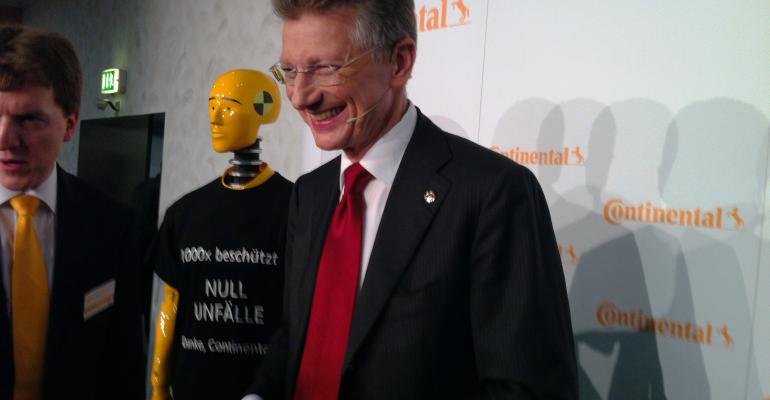FRANKFURT – Continental CEO Elmar Degenhart sees the global supplier’s driver-assistance technologies, which already account for 60% of its annual revenue, outperforming industry growth in the coming years and dismisses softening of the Chinese market as short-term.
“China is a surprise for everybody,” Degenhart tells WardsAuto on the sidelines of the Frankfurt auto show. “The market is developing weaker than expected, no doubt about it.”
Automakers Volkswagen and General Motors reportedly are curbing production in the once-booming market. The VDA, Germany’s auto industry group, on Monday halved its sales-growth forecast for China to 3%.
But Degenhart warns it is not time to panic.
“It is a pausing,” he says. “We knew it would come. It came a little earlier than expected. But overall the market will continue to grow.”
The chief executive says Continental will base its China business on expectations of 24 million-25 million units of light-vehicle production this year. Over time, he says, it will grow to 30 million builds annually.
“The only question is how fast, but if it develops a little bit slower that is not a pity. It is not a problem,” he says.
At least not for Continental. Its interest in the North American and European markets remains robust. Earlier this year, the Hanover, Germany-based parts-making titan raised its sales outlook to €39 billion ($44.1 billion) from €38.5 billion ($43.5 billion).
“The North American and European markets are doing moderately better than expected, so we have opportunities to compensate for the issues in China,” Degenhart says.
Demand is particularly brisk for Continental’s connected-vehicle, driver-assist and efficiency-boosting technologies, which including their related electronics accounts for 60% of its business. Last year, the segment generated revenue of €12 billion ($13.6 billion) of revenue.
“So there is no reason to lean back or to be frustrated,” he adds. “We are excited about what we are doing.”
At the world’s largest auto show here, Degenhart checks off a suite of technologies Continental either offers presently or will be rolling out in the coming years. Those include building blocks to fully autonomous driving, which the supplier expects will be realized in certain situations by 2025, and a new tire technology for improved handling, grip and safety. Degenhart says Continental’s tire unit also is researching a tire technology aimed at sensing road conditions and adapting to improve safety and efficiency.
Continental also shows wing- and interior-mirror technology using cameras it believes will enhance safety by giving drivers a wider field of vision, as well as a future 48V electrical architecture for hybrid applications expected to improve efficiency by 20%.
Degenhart remains conservative in his outlook for battery-electric vehicles, saying the alternative propulsion will need a breakthrough in battery-cell technology not expected until as late as 2030 to see volume production. Federal incentives for research and building an infrastructure are needed, too.
“We’re talking billions (of euros),” he offers. “We are not talking a little money.”
Degenhart says Continental would consider a partner for research on battery technology after quitting a JV last year with South Korea’s SK Innovation because of weak demand for EVs.
“We are thinking about what to do strategically in the future,” he says.





